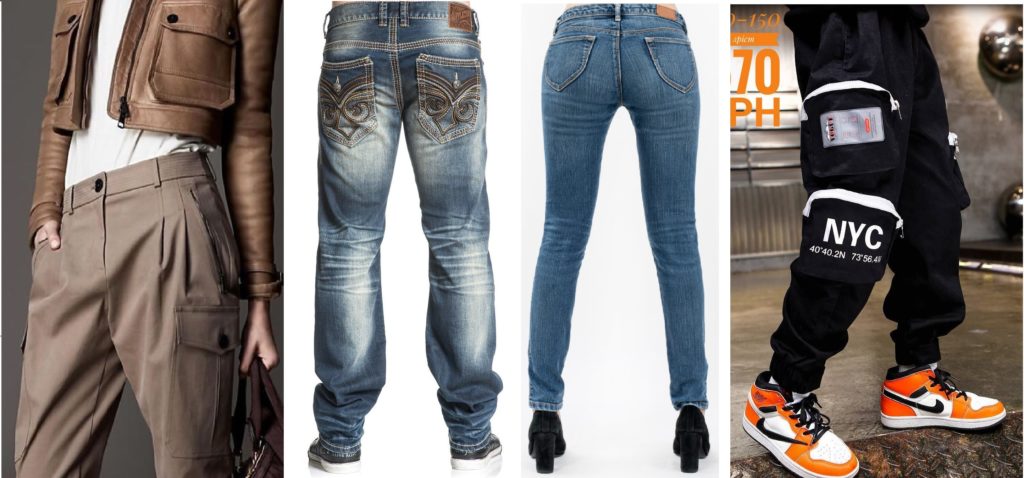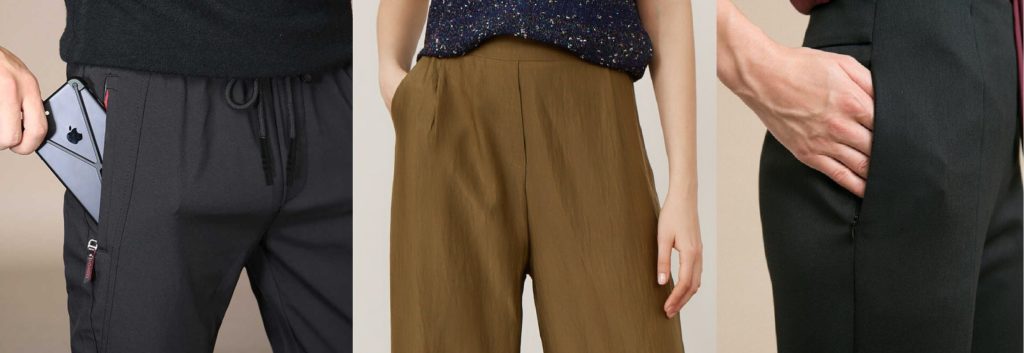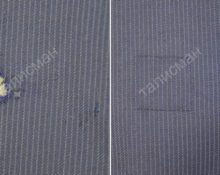A pocket is an additional piece of clothing that performs two main functions: decorative and practical. Firstly, it decorates, especially things with a simple cut. Secondly, you can put your mobile phone, money and keys there. This is especially true for those who like to have their hands free and not encumbered by a handbag or purse. The pocket is found on almost all trousers: men's and women's, light and demi-season. Moreover, in each model there are several of them and not necessarily the same configuration.
Types of pockets on trousers
There are quite a few of them and they vary:
- by size and shape;
- manufacturing technologies;
- location (external and internal);
- accessibility (open and fastened);
- processing method.
Let's look at the main varieties that can be seen on trousers.
Overhead
This is the most common and easiest to make pocket option. It comes in the shape of a square, circle and trapezoid, flat or volumetric. Sewn on top of the main fabric. The size is determined taking into account the style.
By the way! Clothing designers select a place for it by applying and securing a paper template. This is important because the pocket is completely visible and can highlight both the strengths and weaknesses of the figure. Visually, it almost always enlarges the part on which it is located.
Most often on trousers such a pocket is located at the back, less often - on the side just above the knee. It can be open and with a valve, fixed with a rivet or Velcro, or not fastened at all. There are options with different finishes, for example, jeans often have contrasting stitching, embroidery and fittings. Men's models, as a rule, are more ascetic, but on women's models you can see trim, piping, flounces, and rhinestones.

Note! A welt pocket, or rather its treatment, looks neat and businesslike and is often found on the back of office trousers. Therefore, some seamstresses deliberately make a “fake”: there is decor, but there is no pocket as such.
In the seam
The pocket is sewn into the side cut, it is almost invisible and looks laconic. Quite easy to process, much depends on the location of the seam. Sweatpants often have a zipper. In lightweight women's models, it is mostly open.

With undercut side
This option can be found on business or sports pants; its distinctive feature is an oblique cut. It consists of two parts: burlap and barrel. These parts can be made of different materials: main (visible part) and lining. On classic trousers the cut is usually straight, on denim trousers it is semicircular.

@cstor.nn2.ru, @levi
Obviously, the trend of pockets on trousers will never lose its relevance. Fashion designers rarely ignore this detail.It looks great in any version, adds completeness to the image, and emphasizes the chosen style. Business people prefer classic, neatly designed welt and side pockets. Young people choose voluminous invoices. Children love it when there are a lot of them and they are all of different configurations. In any case, a pocket on trousers is necessary, and what it is for - beauty or usefulness - everyone decides for himself.


 0
0





Dear author of the article, where, when and who (tailor, cutter, fashion designer) did you study? What textbooks did you get your “terminology” from?.. When I was studying, the terminology was as follows:
* welt pocket “in the frame” (can be with or without a flap),
* welt pocket “with a leaf” (can be with or without a flap),
* pockets “in the side seams” (usually used in suit trousers),
* pockets “in the seams of the front halves of the trousers” (used in both suit trousers and denim trousers, they just differ in shape),
* stitch, topstitch, topstitch,
* stitch in, stitch in,
* “to sew in a zipper” has never been used in professional vocabulary; a zipper can be “inserted.”